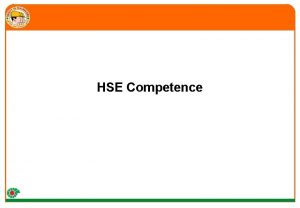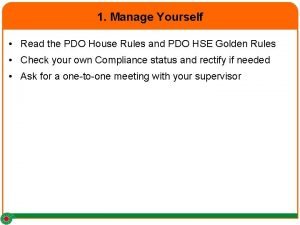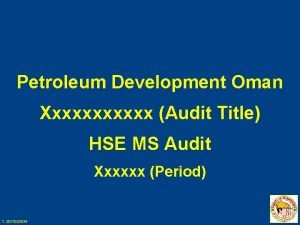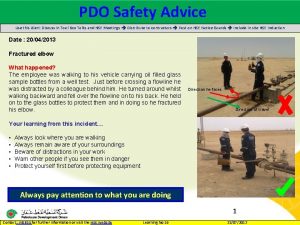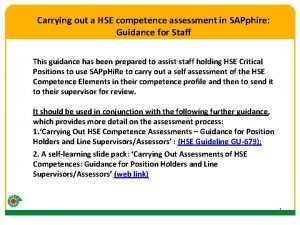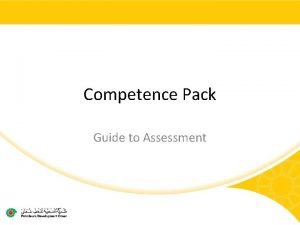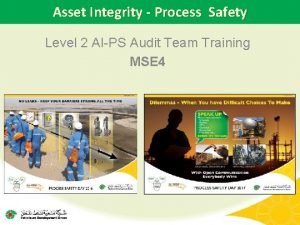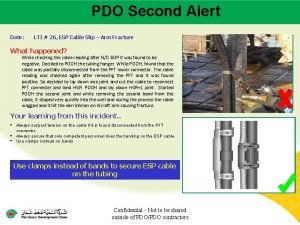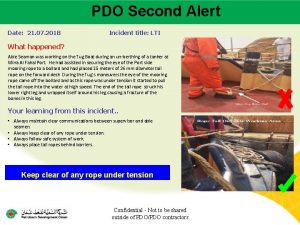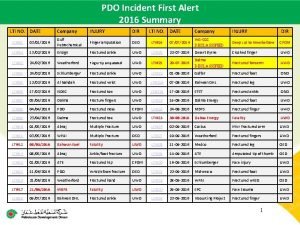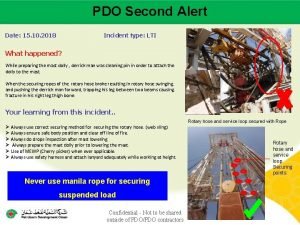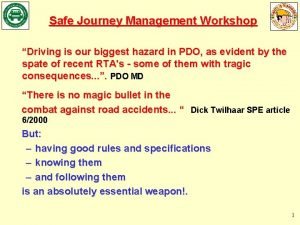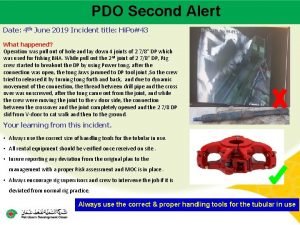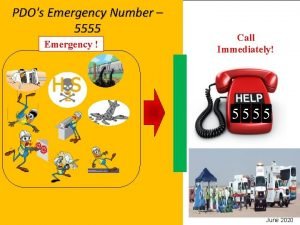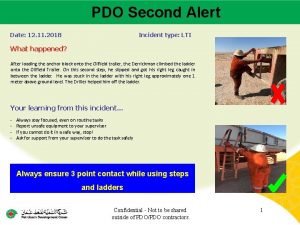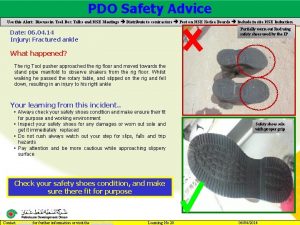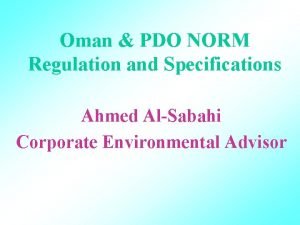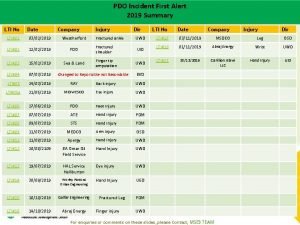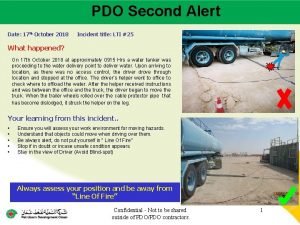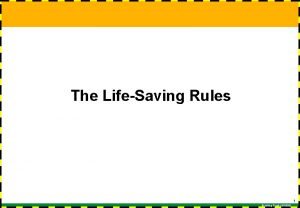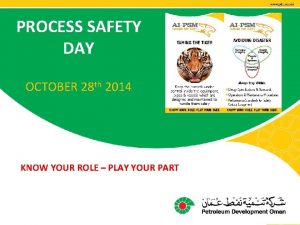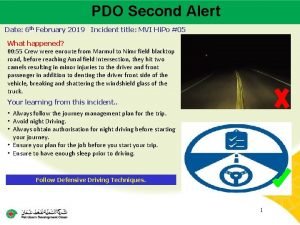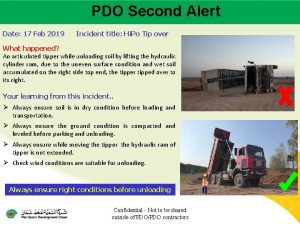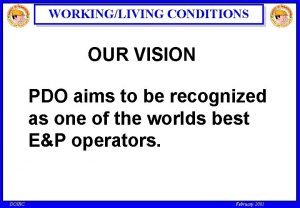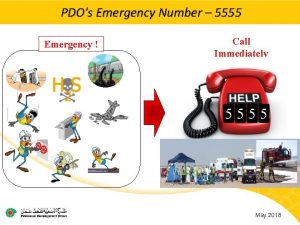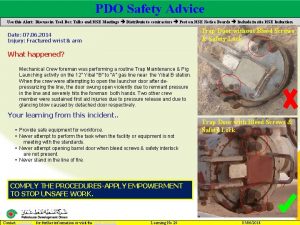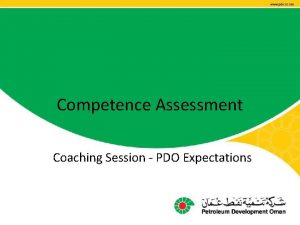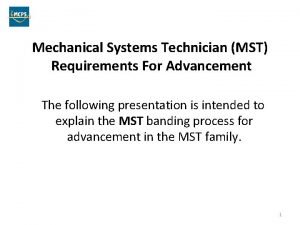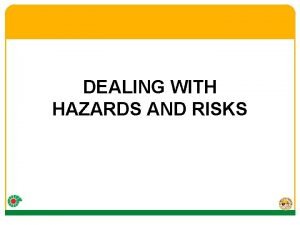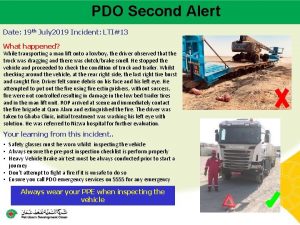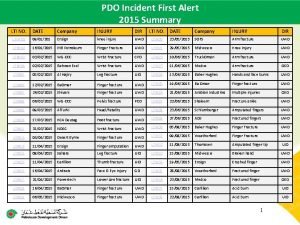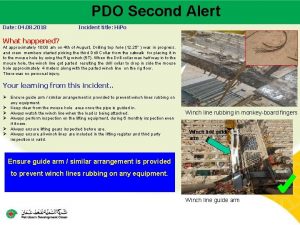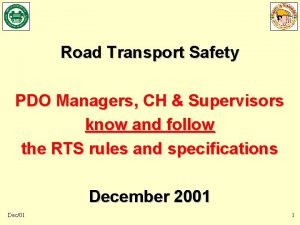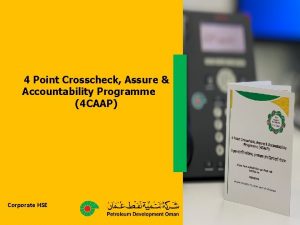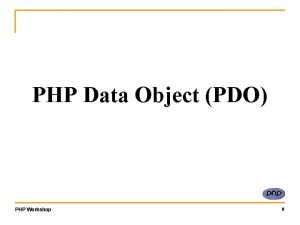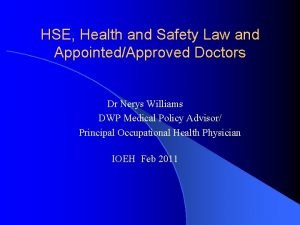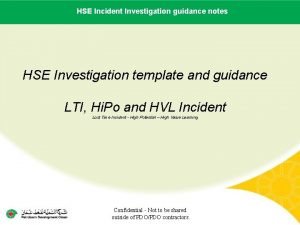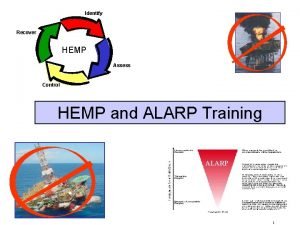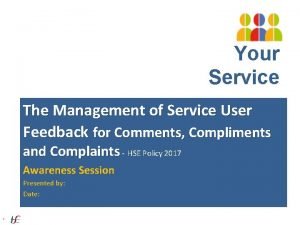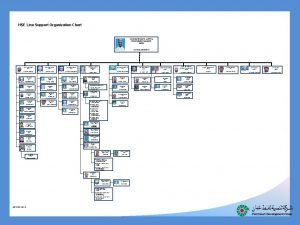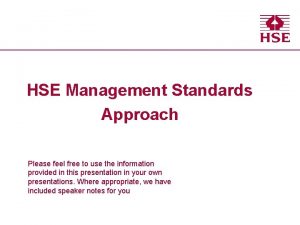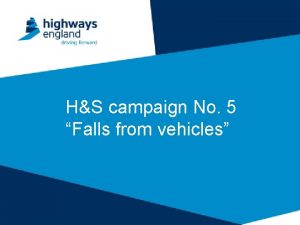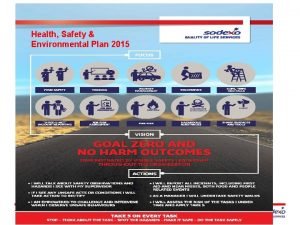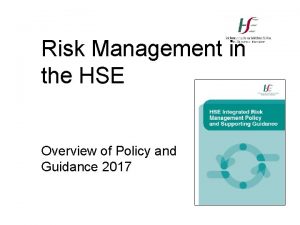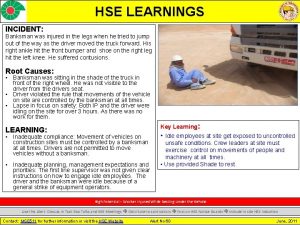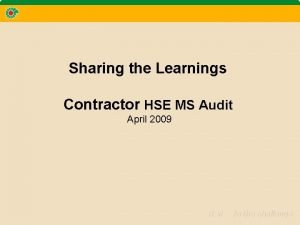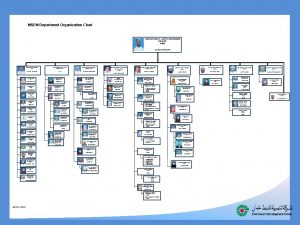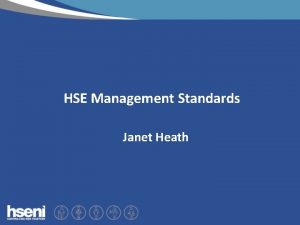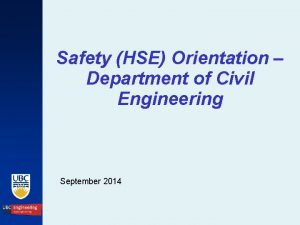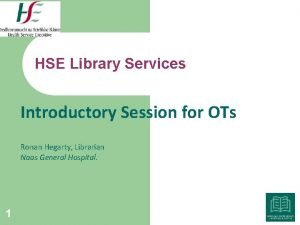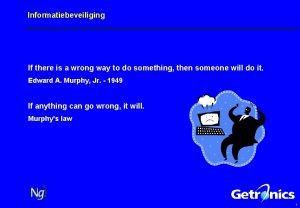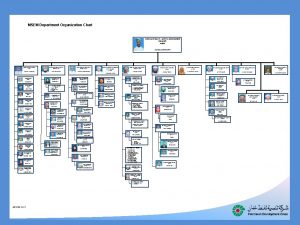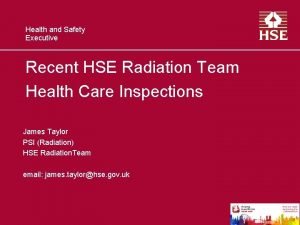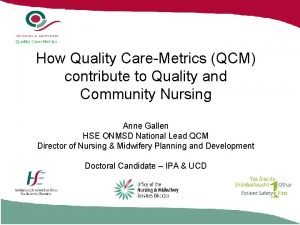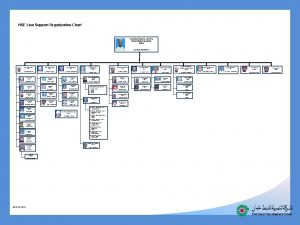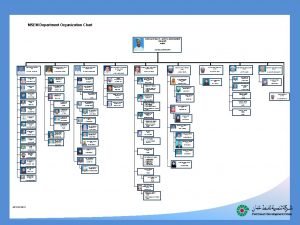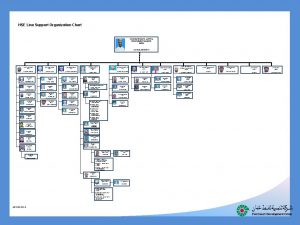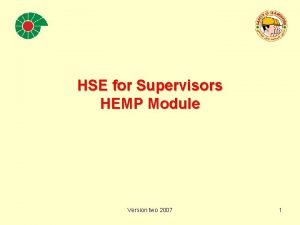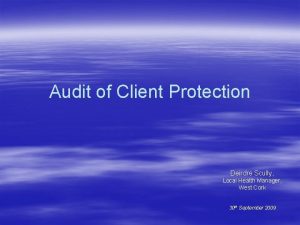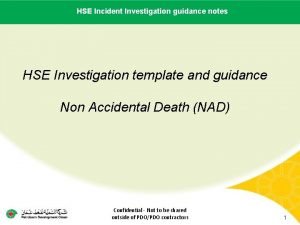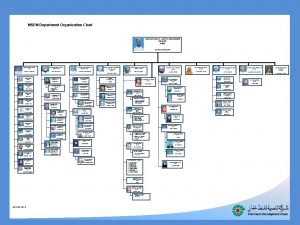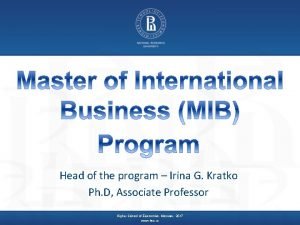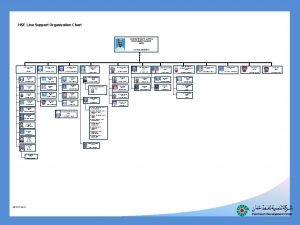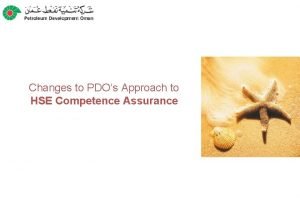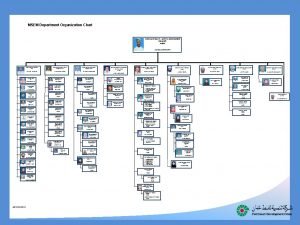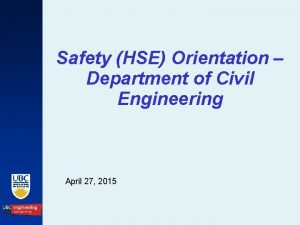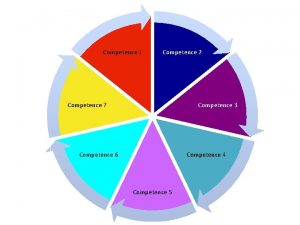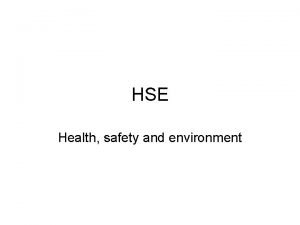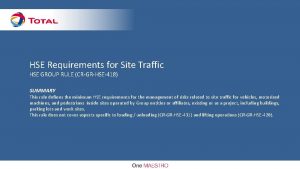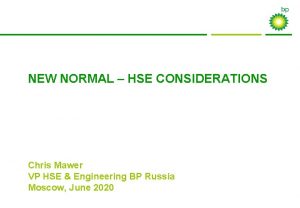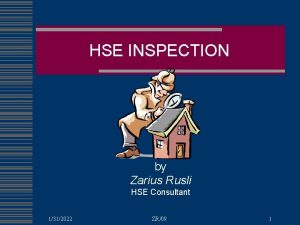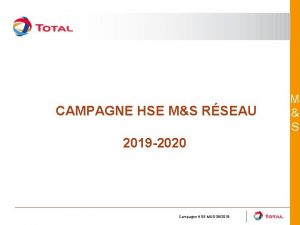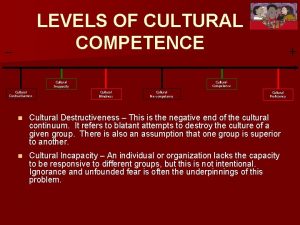HSE Competence PDO Expectations Challenges 1 2 3
















































































































- Slides: 112

HSE Competence

PDO Expectations - Challenges 1. 2. 3. 4. 5. Lack of standards/Guidance Lack of understanding (clarity) - what is the deliverable (Need more assistance road map to get there)? – Variety of operations (Concern over potential work stoppage!) Senior Management, Lack of commitment – don’t see/only feel the cost impact? – The current oil price has an impact! Financial restrictions (lowest bidder mentality) – Not able to execute the assessments Lack of competent resources (assessors) – Lack of finance to achieve the competence framework – Inflexibility to deal with variation to contract? High attrition rate of staff-leavers/joiners – Trainees move company – Appointed too early – Budget for the competent position

DHL 3

PR 1171 Part II 4

Session Objectives Today’s sessions are designed to help you to: • Understand explain to others the company’s revised HSE competence assurance requirements; • Provide advice and support to individuals and supervisors on carrying out assessments; • Understand perform the role of an authorised assessor.

Training Objectives By the end of the day you should be able to: • Understand describe the new PDO HSE Competence Framework; • Understand describe the requirements and process for HSE Competence Assurance of a HSE Critical Position; • Describe the role and responsibilities of of an authorised assessor, including how to use and to record required information in SAPp. Hi. Re; • Understand the criteria that need to be met at A, K & S level for each of the three new HSE MS competences; • Analyse a self-assessment and CV and plan for an assessment interview; • Understand how to conduct an assessment interview, using sound questioning techniques, to reach conclusions on an individual’s levels of competence and to provide feedback; • Understand how to define ‘gaps’ and make recommendations for addressing them; • Understand the key issues, which may arise during the assessment process and how to deal with them.

What We Will Cover • The Competence Scale; • Changes to PDO’s Approach to HSE Competence Assurance • Carrying out an Assessment – General Guidance • The Competence Elements & Proof Points; • Gathering/Analysing Evidence and Questioning Techniques; • Conducting the Assessment Discussion (Interview); • Defining Gaps, Giving Feedback and Recommendations • Recording the Assessment Outcomes Identify issues for discussion and resolution as we go through

Introductions Introduce yourself (in 45 seconds) by telling us: • Who you are and your current position; • A brief description of your experience in carrying out HSE competences assessments; • What you have found most difficult when carrying out such assessments. 10

The Competence Scale

Competence scale Proficiency description 1. Awareness 2. Knowledge 3. Skill 4. Mastery • Able to describe the main elements of the area of expertise and their importance to the business and • Able to recognise how and where competences in the area of expertise are relevant to own job. Key Determinants: Are they familiar with the basics ? Do they know why they are important ?

Competence scale 1. Awareness 2. Knowledge 3. Skill 4. Mastery Proficiency description • Know and able to use correctly the terminology (vocabulary) of the area of expertise and • Able to hold an informed debate with experts in the area of expertise and • Able to ask questions that test the viability of proposals in an area of expertise and • Able to carry out some of the activities with help Key Determinants: Can they hold a meaningful discussion ? Do they have adequate, practical exposure ?

Competence scale 1. Awareness 2. Knowledge 3. Skill 4. Mastery Key Determinants: Have they taken a leading, independent role and solved problems ? Proficiency description • Being able to carry out consistently the activities of an Area of Expertise to the required standardand • Able to translate guidelines and standards for the area of expertise into practical actions and • Able to solve imaginatively, common technical/operational problems in the area of expertise and • Able to guide and advise others in technical/operational aspects of the areas of expertise. Based on HAS DONE, not COULD DO

Competence scale 1. Awareness 2. Knowledge 3. Skill 4. Mastery Proficiency description • Able to creatively solve significant, complex, non-routine problems in the area of expertise and • Able to adapt practices from other markets or countries for use in the area of expertise and • Able to generate substantial improvements to practices and procedures for the area of expertise. Key Determinants: Have they personally developed innovative best practice, which is widely recognised as such ? Are they recognised (inside and outside the company) as an ‘expert’ ?

Competence Scale: Summary 1. Awareness Are they familiar with the basics ? Do they know why they are important ? 2. Knowledge Can they hold a meaningful discussion ? Do they have adequate, practical exposure ? 3. Skill Have they taken a leading, independent role and solved problems ? 4. Mastery Have they personally developed innovative best practice, which is widely recognised as such ? Are they recognised (inside and outside the company) as an ‘expert’ ?

Competence Scale: An Important Reality • The assessment process requires a specific proficiency level (A, K or S) to be determined for each competence; • However, the reality is that the level is often somewhere in between; • For example, someone may meet all the K level requirements and some of the S level requirements, but not all of them; • The result is that he/she is assessed at Knowledge; • An important role of the assessor is to define and explain what the missing aspects of the competence are and to recommend actions to address any gaps(s).

Changes to PDO’s Approach to HSE Competence Assurance

Why do we do HSE Competence Assurance ? • To give the management and key stakeholders reasonable confidence that people holding HSE critical positions have the competences needed to do the job effectively; • To provide an opportunity to identify and agree with individuals the priority areas for short/medium term competence development.

What Are the Key Components of an Effective Competence Assurance Process ? Criteria for Defined Competence Identifying Positions Standards for those to be Assured Positions Structured/Objective Assessment Against Standards Active Management of ‘Gaps’

How does Competence Assessment link with Competence Development ? • Competence Development requires Individuals and their Supervisors to plan actions to meet both current and future competence needs. • Competence Assessment focuses on identifying current competence level and needs (‘gaps’). • It also provides a platform for identifying longer term development needs. • Agreed actions to address both short term and longer term development needs should be recorded in: – The annual Business Goals and Individual Development Goals (IDG) within the Goals & Performance Appraisal (GPA). – The longer-term Individual/Personal Development Plan (IDP/PDP).

Changes to HSE Competence Assurance • A number of significant changes are being introduced to PDO’s requirements for HSE competence assurance of: – Leadership Positions – HSE Critical Positions responsible for Planning/Supervisory HSE Critical Activities (formerly called ‘Level 2 HSE Critical Positions’) • The changes are based on the new approach adopted by the Shell Group, but tailored to PDO’s operating environment • The main objectives of the changes are reductions in: – the number of positions requiring assurance; – the number of potential competence requirement profiles; – the number of HSE competences to be assured. • For the moment, requirements will remain unchanged for the assurance of: – HSE Professional Positions and – HSE Critical Positions Responsible for Front-Line Operational HSE Critical Activities (formerly designated ‘Level 1 HSE Critical Positions’)

Changes to HSE Competence Assurance The Overall Process Remains Unchanged Competence Assessment Process N. B. The Line Supervisor carries out the assessment unless they are not confident In their own competence and capability to do so, in which case they can invite input from an approved assessor

Changes to HSE Competence Assurance Summary of Changes* Positions Requiring Assurance § All positions JG 1+ § ‘Level 2 HSE Critical Positions’ Which Competences Require Assurance § Technical/Operational Competences (as set by the Discipline) in SAPp. Hi. Re § HSE Competences HSE Competence Requirements § 18 Profiles (driven by Function & JG) § Only Senior LT members (Exec Directors) § HSE Critical Positions Responsible for Planning/Supervisory HSE Critical Activities (but more narrowly defined - only those managing ‘Red RAM’ Risks) § Unchanged BUT the number of Competence Elements is reduced from 12 to 3 § 9 Profiles (driven by role in HSE risk management) * N. B. The changes adopted apply only to Leadership Positions and HSE Critical Positions Responsible for Planning/Supervisory HSE Critical Activities. The requirements applying to HSE Professional Positions and HSE Critical Positions Responsible for Front-Line Operational HSE Critical Activities (formerly called ‘Level 1 HSE Critical Positions’) remain unchanged

Changes to HSE Competence Assurance Criteria for HSE Critical Positions Responsible for Planning/Supervisory HSE Critical Activities • The principal criterion is that the position has a significant influence on the management of Red RAM Risks • Such influence arises because they either: o Take (with a high degree of independence) significant technical or planning decisions, which affect the establishment, implementation and maintenance of controls for such risks and/or o They supervise or manage front-line operational activity involving such risks (and therefore are responsible for effective implementation of controls)

Changes to HSE Competence Assurance Comparison of 12 Old & 3 New HSE Competences Rationalised HSE Competences 1 - Provide Leadership in HSSE (‘HSE Lead’) 2 – Prepare Effective Management of HSSE Risk (‘HSE Prepare’) 3 – Apply Effective Management of HSSE Risk (‘HSE Apply’) Shell Uses the term HSSE, PDO will continue to use HSE There is linkage between the old and the new, but the new structure consolidates and reduces the ‘technical/professional’ HSE requirements and focuses on capabilities required by Line personnel N. B. Existing completed assessments in SAPp. Hi. Re will be automatically ‘converted’

Changes to HSE Competence Assurance Structure of New HSE Competence Elements • The structure of HSE Competence Elements remains the same; – Each consists of a Summary Statement, which includes a list of the activities it encompasses; – The Proficiency Levels (Awareness, Knowledge & Skill) remain unchanged; – Proof Points (competence criteria) have been set for each Proficiency Level of each Competence Element; • PDO has adopted the new Shell competence Summary Statements and Proof Points but with some minor tailoring to ensure clarity and understanding in the PDO operating environment; • PDO will not use ‘Mastery’ (no positions require it)

Changes to HSE Competence Assurance New HSE Competence Elements Lead HSE Risk Management (‘HSE Lead’) – Summary Statement/Activities Can deliver continuous improvement of HSE performance through pro-active HSE management, relentless pursuit of adherence to policy and standards, exemplary personal leadership behaviour, provision of appropriate organisation and resources, and systematic review of effectiveness. Specific activities covered by the scope of ‘HSE Lead’ are: - Be mindful of HSE risks and drive the consistent application of PDO’s HSE MS, systematically reviewing its effectiveness and taking corrective action as necessary. - Demonstrate visible and felt leadership by communicating a clear vision, setting and championing challenging performance goals (such as Goal Zero) and consistently demonstrating the importance of HSE via personal involvement, visibility, decisions and actions. - Motivate, coach and develop staff and contractors towards improving HSE culture and behaviours through promotion of the Golden Rules and personal example as a role model. - Deliver compliance with applicable laws, regulations and PDO HSE requirements, applying consistent Consequence Management. - Engage with stakeholders and set long-term HSE objectives in line with expectations whilst adhering to HSE Policy. Take ownership of HSE input to the PDO Annual Assurance Letter.

Changes to HSE Competence Assurance New HSE Competence Elements Lead HSE Risk Management (‘HSE Lead’) The key components at Skill level are: - Demanding and achieving high standards of HSE commitment in other people - Influencing others via own personal behaviour; showing ‘courage’ - Taking actions to positively change HSE related behaviour (Culture) - Continuously challenging standards, identifying weaknesses and driving improvement - Communicating a vision and long-term HSE goals, which others subscribe to - Defining/communicating a clear path (set of priorities) to achieve those goals - Promoting compliance and applying just, fair and consistent recognition and consequence management Its all about establishing a strong, positive, consistent HSE culture and providing clear direction and motivation

Changes to HSE Competence Assurance New HSE Competence Elements Prepare HSE Risk Management (‘HSE Prepare’) – Summary Statement/Activities Can identify and assess HSE risks systematically and define the standards, plans, procedures and resources necessary to manage them. Specific activities covered by the scope of ‘HSE Prepare’ are: - Identify the HSE hazards and assess the potential consequences. - Define the barriers required to control the identified HSE hazards and the recovery measures needed. - Select, establish and maintain the required resources, standards and procedures to manage business, personal and process HSE risks (including during change and across organisational interfaces). - Identify those positions (HSE Critical Positions) responsible for the implementation or management of controls to prevent significant incidents and maintain adequate competence. - Establish HSE action plans and targets integrated within overall business plans. - Establish required emergency response capability and plans. - Establish risk based audit plans to assure compliance with relevant standards and requirements.

Changes to HSE Competence Assurance New HSE Competence Elements Prepare HSE Risk Management (‘HSE Prepare’) The key components at Skill level are: - Ensuring that a sound framework and processes are in place in the business for assessing HSE risks and establishing controls - Challenging controls to ensure that they represent ALARP - Defining the procedures needed to ensure controls are effective - Ensuring that staff have the required competences to ensure controls are understood and effectively applied - Ensuring that HSE issues are properly incorporated into business plans - Ensuring that plans are in place to deal with possible emergencies - Ensuring that assurance plans are in place to monitor the effectiveness of controls It’s all about ensuring that robust HEMP processes and HSE related plans are put in place

Changes to HSE Competence Assurance New HSE Competence Elements Apply Effective HSE Risk Management (‘HSE Apply’) – Summary Statement/Activities Implement the policy, strategic objectives, plans and identified risk management requirements, establish safe systems of work and monitor effectiveness through audit and performance management. Classify, investigate and report incidents in a systematic way, in accordance with PDO requirements. Specific activities covered by the scope of ‘HSE Apply’ are: - Implement systematic HSE management in accordance with the HSE-MS. - Establish safe systems of work so that HSE risk remains as low as reasonably practicable for work undertaken. - Monitor and review activities to ensure continuous improvement in HSE performance whilst updating relevant standards and procedures as necessary. - Monitor and analyse HSE performance using both reactive (lagging) and proactive (leading) indicators, in accordance with PDO Standards. - Classify, investigate and report incidents systematically, in line with PDO requirements. - Identify underlying causes of incidents using appropriate tools and implement appropriate actions. - Participate in relevant internal audits to confirm that risk controls are in place and effective

Changes to HSE Competence Assurance New HSE Competence Elements Prepare HSE Risk Management (‘HSE Apply’) The key components at Skill level are: - Ensuring controls and Safe Systems of Work are consistently implemented - Maintaining controls that represent ALARP - Managing the HSE risks of change - Analysing performance and taking corrective actions as needed - Incident management (investigation and responses) - Ensuring audit and inspection plans are carried out and findings implemented - Managing ER situations It’s all about the front line management of HSE

Changes to HSE Competence Assurance New HSE Competence Requirement Profiles § § § 18 profiles/12 elements (Yellow Guide) rationalised to 9 profiles/3 elements New approach requires selection of best profile to suit role in risk management rather than profile being determined by Job Type/Group Already completed assessments will be ‘converted’ from 12 to 3 in SAPp. Hi. Re Competence Element HSSE Lead Provide Leadership in HSSE Prepare Effective Management of HSSE Risk Apply Effective Management of HSSE Risk HSSE Apply N. B. Shell Uses the term HSSE, PDO will continue to use HSE Planning/Supervisory HSSE Critical Positions Leadership Positions Fn’l Sup’t Gen Mgt/ Bus Ops/ Tech/ Eng LDR-1 LDR-2 LDR-3 SPT-1 SPT-2 OTE-1 OTE-2 OTE-3 OTE-4 K S S A K K K S S A K K A A K S Systems Support Ops/Tech/Eng

Changes to HSE Competence Assurance Criteria for Leadership Positions that directly influence HSE decision making at Leadership Team level. In PDO such positions have been defined as Executive Director positions Leadership Profile LDR-1 (K, A, A) Functional Support Leader LDR-2 (S, K, K) General Mgt/ Business Leader LDR-3 (S, S, K) Ops/Tech/Eng Leader Influence on HSE Risk Management Supports development of HSE policy strategy and business objectives. Enables a positive HSE culture Sets HSE policy, strategy and business objectives. Leads positive HSE culture Sets HSE policy, strategy and business objectives. Provides steer on technical arrangements and resource priorities. Champions positive HSE culture Typical Position Type PDO Leadership Positions Senior Management position at Leadership Team level with Support Function responsibilities - Finance Director - HR Director - Director, Corporate Planning Senior Management position at Leadership Team level with General Business responsibilities Senior Management position at Leadership Team level with Operational, Technical or Engineering responsibilities - Managing Director - Gas Director - Oil Director North - Oil Director South - Technical Director - Exploration Director - Well Engineering Director - Petroleum Engineering Director - Infrastructure Director - Engineering & Operations Director

Changes to HSE Competence Assurance Criteria for HSE Critical Positions Responsible for Planning/Supervisory HSE Critical Activities Position Profile SPT-1 (A, A, A) Systems Support SPT-2 (K, K, A) Systems Support OTE-1 (A, K, K) Ops/Tech/Eng OTE-2 (K, K, S) Ops/Tech/Eng OTE-3 (S, S, K) Ops/Tech/Eng OTE-4 (S, S, S) Ops/Tech/Eng Influence on HSE Risk Management Can significantly affect technical plans, schedules, practices and resources Will significantly affect technical plans, schedules, practices and resources Responsible for procedure and practice in own discipline, operation or trade area Typical Position Type Typical PDO Positions Supervisor of team(s) supporting HSE - Discipline Senior Engineer Critical Activities - Discipline Lead Engineer - Well Integrity Specialist - Head of Lab Services - QA/QC Lead Engineer Operational, Technical or Engineering - Production Operator positions leading a Hands-On - Maintenance Lead (single Discipline or Trade Team discipline) - Hoist Supervisor Responsible for procedure and Operational, Technical or Engineering - Drilling Supervisor practice in own discipline, operation positions leading a number of - Production Supervisor or trade area and those interfacing disciplines, a shift or project - Maintenance Coordinator workflow Directly Responsible. Operational, Technical or Engineering - Delivery Team Leader position managing a project, technical - Ops Mgr Defines ALARP department or asset (primarily offsite) - Engineering Project Mgr - SWE Ops Ultimately Accountable Operational, Technical or Engineering - Production Coordinator position managing a major asset, - Field SWE Delivers ALARP group of small assets, major project or - Head of Construction (Field) technical discipline Manager of team(s) supporting HSE Critical Activities A review of Critical Positions has taken place in conjunction with SPMs Updated Positions & Position Profiles have been identified in SAPp. Hi. Re

Carrying Out Assessments of HSE Competences – General Guidance

Available Guidance/Reference Material • A formal HSE Procedure (PR HSE 1980) ‘HSE Competence Assurance of Leadership Positions and HSE Critical Positions Responsible for Planning/Supervisory HSE Critical Activities; • Formal guidance on carrying out an HSE competence assessment can be found in the form of a HSE Guideline (HSE Guideline GU-679); • A self-learning slide pack (HSE Competence Assessment – Guidance Pack), which summarises the formal guidance for Position Holders, Supervisors and Assessors; More detailed guidance on how to access and use the Competence module of SAPp. Hi. Re can be found in three other self-learning modules (available from MSE 5): – (For Employees; For Supervisors; For Assessors) • If you require further guidance on SAPp. Hi. Re issues, you should contact the SAP help desk on 1111; • • It is recommended that you access and print-off a copy of the HSE Guideline and the relevant SAPp. Hi. Re guidance for use as a reference, when completing an assessment.

Assessment: The Six Steps 1. Competence requirement reviewed and agreed 2. Individual completes a self assessment in SAPp. Hi. Re 3. Self assessment reviewed by line supervisor/assessor 4. Assessment discussion between individual and line supervisor/assessor: decisions and feedback 5. Actions agreed to mitigate any gaps identified 6. Assessment outcome and actions recorded in SAPp. Hi. Re

1. Competence requirement reviewed and agreed Guidance for Position Holders & Line Supervisors • Competence requirements for each of the 3 HSE competence elements (HSE Lead, HSE Prepare & HSE Apply) should already have been included in the overall competence requirements for the position in SAPp. Hi. Re; • To view the competence requirements for the position you need to use the ‘Print’ facility in SAPp. Hi. Re to download and print off a file version of the competences (see detailed SAPp. Hi. Re guidance); • The details of the Proof Points for each HSE competence element can be found in Procedure HSE-1980. They can also be accessed via the web link provided in SAPp. Hi. Re.

Guidance for Position Holders & Line Supervisors • The individual and line supervisor should check that the requirements make sense in relation to the HSE risk management demands of the position; • If no requirements are shown in SAPp. Hi. Re or if the requirements seem wrong, contact your Skill Pool Manager or the HSE Skill Pool Manager; • The supervisor should decide whether he will carry out the assessment or will need the input of an authorised assessor; • If an assessor is to be used, or possibly used, the name of the assessor should be entered into SAPp. Hi. Re by the position holder and this has to be done before the self-assessment is submitted for review (see detailed SAPp. Hi. Re guidance)

Potential Issue: Inappropriate Position Requirements • It is possible, at some point in the process, that the assessor may have doubts that the competence requirement profile assigned to the position is not appropriate; this may happen when you receive the self assessment or during the assessment discussion; • Usually it’s either because the requirement is too demanding (allocated OTE-2 when it should be OTE-1) or possibly because the position isn’t really HSE critical; • If you feel that the requirement profile is not correct, before you have started the assessment, you should share your views with the line supervisor, the SPM and MSE 5 and agree whether any change is required; • If your view emerges during the assessment, then you should record your views and the reasons for them in SAPp. Hi. Re and alert the SPM and MSE 5; • You should still complete the assessment discussion and record your conclusions in SAPp. Hi. Re regarding the competence levels of the individual.

Guidance for Position Holders • You should assess your current competence against the requirements for your position (Awareness, Knowledge or Skill) for each of the 3 HSE competence elements (HSE Lead, HSE prepare and HSE Apply); • You should do this by assessing yourself against the detailed Proof Points for that level of competence; • The details of the Proof Points for each HSE competence element can be found in Procedure HSE-1980. They can also be accessed via the following web link: Web Link

Guidance for Position Holders • If you believe you meet all the Proof Points for the required level of competence, you should click the radar button for that level of competence and enter evidence to support your self-assessment; • Relevant and recent evidence should be recorded in the evidence text section in SAPp. Hi. Re to support the self-assessment; • The range and depth of evidence to be recorded depends on the competence level concerned (see following slides); • Evidence can be included in SAPp. Hi. Re in the form of attached documents (see detailed SAPp. Hi. Re guidance)

Evidence Expectations Evidence Required For Awareness: The position holder needs only to state the key positions where the understanding required by the Proof Points has been gained, together with any relevant training, which may have been attended. The Line Supervisor/Assessor may wish to test the level of understanding claimed via some specific questions at the meeting arranged to review the self-assessment. Evidence Required For Knowledge: Slightly more detailed evidence is required of relevant training completed plus examples of where the practical experience required by the Proof Points has been gained. If the Line Supervisor/Assessor does not have sufficient personal experience of the position holders work and does not have sufficient practical, observed evidence to cover all the Proof Points, he/she should explore the level of competence via questions at the meeting arranged to review the self-assessment. Evidence Required For Skill, the position holder should provide specific written examples of when and where he/she took a leading role in carrying out the actions required by the Proof Points. The Line Supervisor/Assessor should satisfy himself/herself that the individual has effectively carried out all the actions required to a satisfactory standard.

Evidence should meet the four CARS criteria Current - the evidence is sufficiently recent to support a conclusion that the Proficiency Level of Competence is still valid; Authentic - the evidence reflects the position holder’s own work; Relevant - the evidence is appropriate for the position and the Competence Element being assessed; Sufficient - the evidence adequately covers all the relevant Proof Points of the Competence Element at the Proficiency Level being assessed.

Guidance for Position Holders • If you believe you do not meet all the Proof Points for the required level of competence, you should list in the evidence box, those Proof Points which you believe you do not meet; • You should then click the radar button for the level of competence in SAPp. Hi. Re for which you believe you meet all the requirements and enter evidence to support your self-assessment; • If you believe you meet all the Proof Points for a higher level of competence than that required for your position, you should click the radar button in SAPp. Hi. Re for the level of competence at which you assess yourself and enter evidence to support your selfassessment; • Once you are happy with your self-assessment, you should submit it to your line supervisor using the ‘Send Assessment’ function.

Guidance for Line Supervisors • You should open the self-assessment (see detailed SAPp. Hi. Re guidance). • If you do not feel competent enough to do the assessment, you should invite help from the authorised assessor identified and named in SAPp. Hi. Re as part of Step 1; • You should do this via the ‘Send Assessment’ function in SAPp. Hi. Re (see detailed SAPp. Hi. Re guidance).

Guidance for Line Supervisors/Assessors • You should review the evidence provided in the self-assessment and consider whether it meets the CARS criteria and fully supports the competence levels self-assessed; • You should consider and access other sources of evidence (see next slide); • In making your assessment, you should consider whether the individual satisfies all the required Proof Points specified for the competence and the proficiency level concerned; • The details of the Proof Points for each HSE competence element can be found in Procedure HSE-1980. They can also be accessed via the following web link: Web Link

Guidance for Line Supervisors/Assessors • Personal Observation provides the most natural form of evidence; it is valid, and reliable; • However, access to first hand evidence of an individual’s performance may not always be possible; • So, what other sources of evidence can be used ? – Individual’s self assessment statements – Work History (CV) • Other options for additional evidence (if considered necessary) – Statements from others who have worked with the individual being assessed – Records, Documents, Products of Work • Assessors should also request a JD if they are not familiar with the role and responsibilities of the individual being assessed

Guidance for Line Supervisors/Assessors • For each competence element, you should consider the evidence provided and your own experience of the individual to make an initial conclusion whether: – The evidence seems to support the self assessment but you may need to check some facts; – The evidence you have is not sufficient to make even an initial conclusion. • For each competence element, decide what you want to find out from the discussion with position holder; • When you have reviewed the self-assessment, you should arrange a faceto-face discussion with the position holder; the review should NOT be done by email and you should NOT simply make your decision without engaging with the position holder.

Exercise 1 -Preparing for the Assessment Assessor’s Brief: • You have been asked to assess someone who works in your business area. You know them by name and face, but not very well. You have received their self-assessment from the line supervisor and are calling the individual to arrange to meet for the assessment interview. NB – a phone call is recommended, rather than making initial contact by email

Exercise 1 Preparing for the Assessment Individual’s Brief • You have been told by your supervisor that you need to go through a ‘HSE competence assessment’ and that you have to complete a selfassessment and send it to your line supervisor. He has asked you to include the name of an assessor in SAPp. Hi. Re, in case he wants to use one instead of doing the assessment himself. • You have been phoned up by the HSE Advisor in your business area, who tells you that he is going to be your ‘assessor’ and wants to meet with you to discuss your self assessment, which has been forwarded to him by yourline supervisor. • You are still not really sure why you are having to do this assessment. You decide to take the opportunity of the call to try to find out more about what the whole thing involves.

Review/Discussion of Competence Elements and Proof Points

Changes to HSE Competence Assurance New HSE Competence Elements Lead HSE Risk Management (‘HSE Lead’) The key components at Skill level are: - Demanding and achieving high standards of HSE commitment in other people - Influencing others via own personal behaviour; showing ‘courage’ - Taking actions to positively change HSE related behaviour (Culture) - Continuously challenging standards, identifying weaknesses and driving improvement - Communicating a vision and long-term HSE goals, which others subscribe to - Defining/communicating a clear path (set of priorities) to achieve those goals - Promoting compliance and applying just, fair and consistent recognition and consequence management Its all about establishing a strong, positive, consistent HSE culture and providing clear direction and motivation

Changes to HSE Competence Assurance New HSE Competence Elements Prepare HSE Risk Management (‘HSE Prepare’) The key components at Skill level are: - Ensuring that a sound framework and processes are in place in the business for assessing HSE risks and establishing controls - Challenging controls to ensure that they represent ALARP - Defining the procedures needed to ensure controls are effective - Ensuring that staff have the required competences to ensure controls are understood and effectively applied - Ensuring that HSE issues are properly incorporated into business plans - Ensuring that plans are in place to deal with possible emergencies - Ensuring that assurance plans are in place to monitor the effectiveness of controls It’s all about ensuring that robust HEMP processes and HSE related plans are put in place

Changes to HSE Competence Assurance New HSE Competence Elements Prepare HSE Risk Management (‘HSE Apply’) The key components at Skill level are: - Ensuring controls and Safe Systems of Work are consistently implemented - Maintaining controls that represent ALARP - Managing the HSE risks of change - Analysing performance and taking corrective actions as needed - Incident management (investigation and responses) - Ensuring audit and inspection plans are carried out and findings implemented - Managing ER situations It’s all about the front line management of HSE

Gathering/Analysing Evidence & Asking the Right Questions

Analysing a CV • A CV can be useful to check whether an individual has had roles and responsibilities, which could have provided him with the opportunity to acquire particular knowledge and experience; • It may even provide relevant examples of having carried out actions relevant for K and/or S level competence; • You should, of course, never accept statements on a CV without asking some relevant questions to check that they represent evidence which satisfies the CARS criteria.

Issue: Does Training = Competence ? • Attendance at relevant training should, of course, be taken into consideration in an assessment; • However, it should be tested against the CARS criteria • Unless training involves a high level of practical learning and testing and has regularly been applied, it is unlikely to contribute more than to Awareness; • Completion of the SOU Knowledge level modules (Lead, Prepare or Apply) should not, automatically, be accepted as adequate evidence of Knowledge level competence !

CV Exercise 1 The Individual is being assessed against OTE-3 requirement (S, S, K) • Quickly read through the CV provided; • Identify evidence/positions which might be relevant for: – HSSE Lead – HSSE Prepare – HSSE Apply • Is the information relevant for A, K or S level ? • Identify any particular aspects of the CV you might want to explore during the assessment discussion

CV Exercise 2 • Quickly read through the example CV (one of ‘candidate assessees’); • Both are to be assessed against OTE-3 requirements (S, S, K) • Identify evidence/positions which might relevant for: – HSSE Lead – HSSE Prepare – HSSE Apply • What levels of competence might it be relevant for ? • Identify any particular aspects of the CV you might want to explore during the assessment discussion

The Effectiveness of the Assessment will depend heavily on the quality of the questions you ask !!!!!

Interview Questions: Funnelling Technique Wide Open Question Invites broad range of information on a relevant topic Specific Open Questions Invites information on a particular aspect of the topic 5 WH used to vigorously probe areas of information Closed Questions Designed to clear-up any issues Topic

Open Questions Wide Open Questions Take Care !!!! Can you please tell me why you think intervening is important ? Can you please tell me about HSE assurance ? Can you please tell me about the HEMP process ? Specific Open Questions Can you please give me some recent examples of situations where you have intervened ? Can you please tell me about recent HSE audits have you taken part in ? Can you please tell me about when you been involved in HEMP exercises, such as HAZIDs or HAZOPs? If in doubt start a question with “Tell me about…. ” But - make sure the question forces the person to give relevant evidence

Probing Questions (Exploring Evidence): Six questioning friends (co called 5 WH ): How Who What When Where Why How did you go about that task. . ? Who gave you guidance on what to do. . ? What was your personal role in the project …? What improvements did you achieve… ? What problems did you have to solve ? When did you last lead such a task ? Where did you go to find info on…? Why did you do it that way …? Notice the emphasis on ‘you’.

Closed Questions & Leading Questions Used Closed Questions Carefully (for checking specific facts) • • Did you lead the team ? Did you actually write the procedure ? Did you prepare the final report ? Was the procedure approved ? Avoid Leading Questions (without follow-up) • But you did take a leading role, didn’t you ? • So that means you wrote the procedure yourself ? • You did prepare the final report your self, didn’t you ? • So you have experience of managing emergency response ?

Evidence Exercise Review the evidence below. What are your thoughts ? Does the Evidence Meet the CARS Critieria ? What further information do you need to come to any conclusions ? HSSE Lead: Set up Ops start up team for Onshore Processing Plant; established ‘no compromise’ HSE culture. Completed start up on time and with zero LTIs despite difficult contractor interfaces to manage. Had to stop contractor work on 2 occasions. Introduced and embedded STOP programme, including reward for best card of the month. Although not contract holder, actively participated in contractor performance reviews and review of HSE management plan. Self Assessed at Skill Prepare TWO initial questions

Some Example Questions ‘HSE Lead’ • What are PDO’s current HSE priorities (‘Must Wins’) ? (K/S) Ø How do you promote them amongst your team/contractors ? • What kind of changes to the HSE culture (behaviour) are you trying to promote with your team/contractors ? (K/S) Ø What problems do you face ? How do you overcome them ? • • How do you demonstrate your personal commitment to HSE ? (K/S) Can you give an example of taking a leading role in changing HSE Culture ? (S) Ø How did you go about it ? What innovations did you introduce ? (S) • What are the Golden Rules ? Why do you think they are important ? What do you do to promote them ? (K/S) • What role do STOP and the LSR play in building a positive HSE culture ? (K) Ø How do you promote constructive intervention ? • • • Tell me how you handle non-compliance; give me some concrete examples; (K/S) What reward/recognition tools have you introduced for good HSE behaviour ? (S) Tell me about the last time you opposed a proposed decision for HSE reasons (S)

Evidence Exercise Review the evidence below. What are your thoughts ? Does the Evidence Meet the CARS Critieria ? What further information do you need to come to any conclusion ? HSSE Prepare: BSP: Contributed to HSE Case development and participated in HEMP studies related to proposed change in maintenance periods. SSB: updated shutdown procedure manual; member of regional ER and crisis team. PDO: Set up maintenance team at Nimr and managed competence via CBD process; produced annual maintenance plan; responsible for 120 contract maintenance staff. Carried out regular safety walkabouts. Self Assessed at Skill Prepare TWO initial questions

Some Example Questions ‘HSE Prepare’ • • What are the main hazards in your area of activity/responsibility ? (K) What sort of HEMP or other forms of risk assessment exercises have you been involved with ? ; (K/S) Ø When did you last taking a leading role in one ? (S) Ø How did you satisfy yourself that ALARP had been reached ? (S) • • • What involvement have you had in putting together an activity plan (e. g. project plan, maintenance plan, shutdown plan) ? (K/S) What involvement have you had in the development/updating of procedures for HSE risk control ? (K/S) How do you ensure that staff/contractors know their HSE responsibilities and the key procedures they have to apply ? (K/S) What involvement have you had in ‘change management’ planning/preparation ? (K/S) What involvement have you had in ER planning ? (K/S) What involvement have you had in inspection/audit planning ? (K/S)

Evidence Exercise Review the evidence below. What are your thoughts ? Does the Evidence Meet the CARS Critieria ? What further information do you need to come to any conclusion ? HSSE Apply: See Handout Self Assessed at Skill Prepare TWO initial questions

Some Example Questions ‘HSE Apply’ • What role/responsibility have you had in the PTW system ? (K/S) • What is the highest risk work that you have responsibility for ? • When did you last: do a PTW inspection; review/approve a JHA; do a TBT (K/S) ? • What do you do to monitor that your staff/contractors have the required competences ? (K/S) • How do you monitor/measure the HSE performance of your staff contractors ? (K/S) • What reports do you use; when have you had to take corrective action ? (K/S) • What actions have you instigated to improve on-site risk control ? (S) • What involvement have you had in actually managing ‘plant change’ or other forms of significant change ? (K/S) • What involvement have you had in incident reporting/investigation and sharing/implementation/close-out of findings/recommendations ? (K/S) • What involvement have you had in carrying out inspections/audits and ensuring followup/close out of findings ? (K/S) • What experience have you had in managing ER situations (exercises) ? (K/S)

Evidence Exercise Review the evidence provided by one of the PDO candidate assessees. Identify the main evidence relevant for • Lead (Skill) • Prepare (Skill) • Apply (Knowledge/Skill) as allocated. Prepare TWO initial questions

Conducting the Assessment Discussion (Interview)

Assessment Discussion (Interview): Recommended Structure Allow 2 -2. 5 hours • Introduction (5 mins) • Review the Job (5 -10 mins) • Review the CV (5 -10 mins) • Review Each Competence Element – provide conclusion & feedback (35 -40/30 -35 mins) • Summary & Next Steps (5 -10 mins)

Opening The Assessment Discussion: • Introduce yourself if you don’t know the person; • Thank the individual for taking the time to do the self-assessment; • Remind the individual of the purpose of the review discussion; • Emphasise that it has 2 important purposes: 1. Risk management (help the company to identify any areas of possible competence exposure); 2. To help individuals to better understand build/reinforce their competence; • Emphasise that it’s not any kind of pass or fail exam; • Remind them of the criteria you will use to assess A, K and S; • Advise them of how you plan to structure the discussion; • Advise on the next steps after the discussion.

Exercise Introducing the Competence Discussion Assessor’s Brief: • You are meeting with the individual to carry out the competence discussion. You have received the individual’s CV, self assessment and JD. You now have 5 -7 mins to set the scene and answer any questions the individual may have before you begin the assessment discussion.

Exercise Introducing the Competence Discussion Individual’s Brief • At the assessor’s request you are now meeting for the competence discussion. You are a little nervous and still unsure about the purpose and implications of the process and what it will lead to. The assessor will give an introduction. You will have the chance to ask any questions (max 2 -3), which you feel you need to before the discussion starts Possible things you may need clarification on: • Why an assessor is doing this and not your line manager • What criteria are used for the assessment • What will happen if any ‘gaps’ are identified • What happens after the discussion has been completed

Understanding the Job Theoretically, you should be able to assess an individual against the defined competence criteria, irrespective of the job. In practice you will have to make judgments on whether the level(s) of competence are sufficient for the person to carry out their job effectively; You should therefore spend a little time exploring the nature of the job and its key challenges: ØLeadership/supervisory challenge: how many direct reportees, discipline staff, contractor staff; ØRisk management role: what hazards, risks & controls management does the job involve (how directly); ØAny contract management responsibilities; ØKey current HSE issues ØExplore proportion of time spent in the office/in the field/on-site; The information gained may provide useful evidence or questions to explore further, later in the interview; Don’t spend too long; focus questions on areas that are relevant for gaining evidence and understanding the job scope; don’t get diverted.

Exploring the CV It is recommended that you spend 5 -10 mins exploring the assessee’s CV with him/her; The objective is to: • Clarify any specific areas you have identified from your review; give emphasis to understanding previous relevant HSE management experience; • Gain a picture of previous experience (hazards, risks, roles), staff/contractor supervisory challenge; The information gained may provide useful evidence or questions to explore further, later in the interview; Don’t spend too long; focus questions on areas that are relevant for gaining evidence; don’t get diverted; you can always refer back to the CV, when discussing a specific competence element; Focus on previous jobs, rather than the current one.

The Competence Assessment Discussion • Work through the competence elements in turn; • It can be helpful to give a quick summary of what the competence element entails and what you will be looking for at A, K or S level; • You have only limited time, so stay in control of the schedule and the discussion; • Make good notes of facts learned and conclusions reached; • Give feedback on your preliminary conclusion, after the discussion of each competence element: – competence level assessed; any gap you believe exists; recommended actions to fill the gap; – if you are uncertain, say so and what you plan to do to reach a conclusion (e. g. speak to line manager) • Don’t be afraid to come to a conclusion and be confident in your judgment; be ready to reconsider if the individual offers further valid evidence.

The Competence Assessment Discussion: Some Do’s and Don’ts If an individual has self-assessed himself at Skill: • Don’t: start asking questions relevant for Awareness • Do: explore the evidence provided and ask questions relevant for Skill; if you are satisfied that they meet the Skill criteria, you don’t need to ask questions relevant for K or A; • Focus initially on establishing when/where a leading role was played in relation to the main proof points If you conclude that there are gaps at the Skill level: • Do: define what the gaps are and actions that are required; • Do: test whethere any significant gaps at K level (the evidence and S level questions should already have given you relevant information).

The Competence Assessment Discussion: Some Do’s and Don’ts If an individual has self-assessed himself at Knowledge: • • Don’t: start asking questions relevant for Awareness Do: explore the evidence provided and ask questions relevant for Knowledge; if you are satisfied that they meet the K level criteria, you don’t need to ask questions relevant for A; If you conclude that there are gaps at the Knowledge level: • • Do: define what the gaps are and actions that are required; Do: test whethere any significant gaps at A level (the evidence and K level questions should already have given you relevant information) If you conclude that there are no gaps at the Knowledge level: • • Don’t: start asking questions relevant for A; Do: ask questions to test S level competence (particularly if the requirement is at S level) and define what gaps exist; .

The Competence Assessment Discussion: Some Scenarios How would you approach the following situations ? : • An individual requires Skill or Knowledge but has selfassessed himself at Knowledge or Awareness, respectively (i. e. lower than the position requirement); • An individual requires Skill or Knowledge but has self assessed himself at Mastery or Skill respectively (i. e. higher than the job requirement)

The Competence Assessment Discussion: Some Scenarios How would you approach the following situations ? : • An individual requires Skill or Knowledge but has selfassessed himself at Knowledge or Awareness, respectively (i. e. lower than the position requirement); Ø Ask the assessee which criteria for Skill they feel they do not meet and why; Ø Ask questions, which test Knowledge level competence but also explore Skill; Ø You will need to satisfy yourself that they do, indeed, meet the Knowledge requirements; Ø Importantly you will need to identify which Skill critieria are not met and recommend actions to address the ‘gaps’.

The Competence Assessment Discussion: Some Scenarios How would you approach the following situations ? : • An individual requires Skill or Knowledge but has self assessed himself at Mastery or Skill respectively (i. e. higher than the job requirement) Ø Use the CV to consider, whether the assessee has held positions, which could provide an opportunity to acquire the higher competence level (Mastery is very unlikely); Ø Explain the criteria for Mastery/Skill; this may result in acceptance that the higher level is not appropriate; Ø If the assessee is insistent that the self-assessment is appropriate ask questions, which test that competence level; this should also help you to assess the lower (required) level; Ø If it becomes clear that the criteria for the required competence level are met and that some (but not all) of the higher level requirements are also met, acknowledge that, both to the assessee and in your notes in SAPp. Hi. Re.

The Competence Assessment Discussion: Some Do’s and Don’ts • Do: always maintain a positive and encouraging approach; • Do: focus on hard facts and evidence; • Don’t: use hearsay, make assumptions or appear to be critical or judgmental; • Do: make your questions as clear and concise as possible; • Do: ask questions, which focus on showing what the individual knows or has done; • Don’t; ask leading or multiple choice questions; • Don’t: ask complicated, intricate or ‘trick’ questions; • Do: try to establish whether the individual has adequate competence relevant for their job; • Don’t: expect them to know as much as you or to have done things that are not relevant or necessary for their job;

The Competence Assessment Discussion: Some Do’s and Don’ts • Do: remember they are line staff and not HSE professionals; • Don’t: try to catch them out or give the impression you are trying to show off your own detailed, specialist knowledge; • Don’t: ask endless questions or ask for more and more evidence unless the outputs are relevant and necessary for you to make a decision. • Do: make your conclusions (and the reasons for them) clear, simple and FAIR; • Do: refer to the evidence provided and use it as a starting point; • Do: make any ‘gap filling’ recommendations concrete and achievable; • Do: make sure the individual understands any recommended actions and what he needs to do • Do: be prepared to make a judgment and conclusion;

4. Assessment discussion between individual and line supervisor: decisions and feedback Guidance for Line Supervisors/Assessors • The assessment process requires a particular proficiency level (A, K or S) to be decided; • However, the reality is often that the level is somewhere in between; • For example, someone may meet all the K level requirements and some of the S level requirements, but not all the ones relevant for the position; • The result is that he/she must be assessed at Knowledge; • It is most important to define and explain what the missing requirements of the competence are and to recommend actions to address the gaps(s).

Competence Gap or Improvement Opportunity ? You will need to make a judgment: • Is this a competence gap (it’s significant; it’s needed for the job; there may be a risk associated with its absence) ? • Is this an improvement opportunity (it’s desirable but not essential; it would help the person do their job even better) ? If it’s a competence gap, you should make that clear and: • State your opinion that the demonstrated competence does not yet meet all the required criteria (i. e. is K not S or is A not K); • Define the gap(s); • Recommend concrete actions to be taken to address the gap If it’s an improvement opportunity, you should make that clear and: • Advise that you believe the demonstrated competence meets the required criteria (unless there are other gaps), but that you believe there is room for strengthening; • Describe the improvement opportunity • Recommend concrete actions to be taken to achieve the improvement.

Adequate Size/Significance? You may need to make a judgment: • Do examples provided as evidence represent adequate levels of challenge or significance to represent Skill level competence ? Ø Number of people involved; complexity; significance; There is no hard and fast rule: • Key considerations: ØWhat capability does the position require ? ØDoes the evidence give you reasonable confidence that the job requirement can be met ? ØDoes the evidence meet the normally accepted understanding of ‘significance’ (e. g. for incidents) If you are happy that the competence is adequate to meet the job demand BUT would not be good to meet the demands of other positions, then make the comment in your feedback and in SAP (‘X is considered to meet the criterion for ‘Lead’ at Skill level within the requirements of the current position, but would need to be re-assessed if he takes up a position with a more demanding requirement’)

4. Assessment discussion between individual and line supervisor: decisions and feedback Guidance for Line Supervisors/Assessors • • • - Usually, you should not identify a gap without making a recommendation on how to close it; Situations may arise, where the individual does not meet a particular Proof Point requirement, but it is difficult to define the action to be taken in the present position to fill the gap; This may be because that particular Proof Point requirement is not relevant to the present position; usually, this arises in the case of Skill requirements; If you cannot define what the person needs to do in his/her current position to demonstrate Skill, then the position may not need that particular Proof Point requirement; The guidance on how to deal with this is: If none of the missing Skill criteria are needed for the job, then the individual should be assessed at Skill and the criteria, which the individual does not meet, should be recorded in SAPp. Hi. Re along with the reasons why they are not needed for the job. If any of the missing Skill criteria are needed for the job, then the individual should be assessed at Knowledge and a recommendation made for filling the gap(s);

Coming to a Conclusion Do You Have Enough Evidence to Decide ? 1. Awareness Are they familiar with the basics ? Do they know why they are important ? 2. Knowledge Can they hold a meaningful discussion ? Do they have practical exposure ? 3. Skill Have they taken a leading, independent role and solved problems ? Is the evidence CARS ? Does it cover the key criteria ? Are there significant things they do not know or have not demonstrated they can do (have done) in relation to their job requirements ? What are the gaps ?

4. Assessment discussion between individual and line supervisor: decisions and feedback Guidance for Line Supervisors/Assessors • Make detailed notes as you go along • Note down key, additional evidence or clarification acquired during the assessment discussion; • Note down the conclusion in terms of level assessed (A, K, S); • Note down what gap(s) you identified against the required criteria; • Note down what feedback you provided and agreed in terms of relevant action to address the gap(s); • After the assessment your comments, conclusions and recommendations will need to be entered into SAPp. Hi. Re

Defining Gaps and Providing Feedback & Recommendations

5. Actions agreed to mitigate any gaps identified Guidance for Line Supervisors/Assessors • Importantly, the discussion should be used to define and discuss any gaps versus the position requirement that the assessment has identified and what actions should be taken to address those gaps; • The appropriate actions should include ones designed to both: – Fill gaps; – Mitigate the possible risks associated with gaps s

5. Actions agreed to mitigate any gaps identified Guidance for Line Supervisors/Assessors • The approach to risk mitigation will potentially involve : – Reallocating the activity to someone who is fully competent; – Providing enhanced supervision and/or support; • You should record, either in SAPp. Hi. Re or elsewhere, any actions recommended to mitigate the potential risks, including any restrictions on the tasks that individuals are permitted to perform; • Competence development actions should be agreed and documented in the annual Performance and Development Review documentation; • You should ensure that the position holder understands the nature of any gap and agrees with any actions you are recommending, including any temporary constraints on activity and/or decision making.

Giving Feedback Share your conclusion after discussion of each competence element (don’t leave the individual in doubt): • What is your conclusion on the competence level and why ? • What gaps, if any, do you believe exists vs the requirement criteria ? • What actions do you recommended to fill the gap ? You may find yourself having to provide a certain amount of coaching in order to explain the gap. But be careful not to turn the assessment into a training session.

Giving Feedback: Addressing Gaps Potentially Relevant Gap Filling Actions: 1. Awareness/Knowledge Gaps • Formal training (with immediate application) • Self Learning On line (SOU) – but take care…. • Self Reading Documents • Participating in relevant activities (e. g. Audit, Investigation, HEMP); 2. Skill Gaps • What hasn’t been proven ? How can this be achieved on the job ? What actions need to be taken ? What needs to be delivered ? Will they need coaching/guidance mentoring initially ? Who can provide that ? • If they will need help the first time round, then that may not be enough to demonstrate Skill; Skill requires the ability to do something independently; • The reality is that it may be opportunity-driven/constrained.

Giving Feedback: Addressing Gaps • Make it very clear what the recommended actions are and who should do what; • ALSO make it clear what the person should do to have any gaps reassessed (including likely time-frame): ØDo a reassessment; provide additional evidence of actions taken and results; ØSubmit to supervisor for resubmission to Assessor; ØFollow-up discussion with Assessor to review

Gap Filling Exercise You have come to the following conclusion HSSE Lead (Requires Knowledge; Assessed Awareness) Gaps Identified: • Is not able to explain with adequate confidence the importance/purpose of STOP and the Life Saving Rules in improving the HSE culture (the behaviors targeted); • Is not able to provide convincing examples of how he demonstrates his personal commitment to own/contractor staff. What Actions Would You Recommend to Manage The Gaps ?

Gap Filling Exercise You have come to the following conclusion HSSE Lead (Requires Skill; Assessed Knowledge) Gaps Identified - cannot provide any solid examples of: • Taking a leading role in changing the HSE behaviour/culture of own or contractor staff; • Taking a leading role in developing/implementing reward or recognition schemes for HSE performance. What Actions Would You Recommend to Manage The Gaps ?

Gap Filling Exercise You have come to the following conclusion HSSE Prepare (Requires Knowledge; Assessed Awareness) Gaps Identified: • Has had no practical involvement in the HEMP process (and has limited understanding of the allied terminology/techniques); • Is unfamiliar with the concept of ‘management of change’ and is unable to give examples of what circumstances, in his area of responsibility, might be considered a ‘change’ situation; • The actions described to ensure contractor staff in own area are fully familiar with ER requirements are not considered adequate. What Actions Would You Recommend to Manage The Gaps ?

Gap Filling Exercise You have come to the following conclusion HSSE Prepare (Requires Skill; Assessed Knowledge) Gaps Identified - cannot provide any solid examples of: • Taking a leading role in establishing a risk assessment framework or a in a relevant HEMP exercise; • Taking a leading role in the production of any kind of action/project plan, which incorporates HSE requirements; • Taking a leading role in establishing and maintaining ER procedures and capability. What Actions Would You Recommend to Manage The Gaps ?

Gap Filling Exercise You have come to the following conclusion HSSE Apply (Requires Knowledge; Assessed Awareness) Gaps Identified: • Cannot explain the HSE critical tasks, for which he has responsibility; • Has not had practical experience with using PTW for managing key high risk activity relevant to own work; • Has had no practical experience in incident investigation and no familiarity with RCA. What Actions Would You Recommend to Manage The Gaps ?

Gap Filling Exercise You have come to the following conclusion HSSE Apply (Requires Skill; Assessed Knowledge) Gaps Identified - cannot provide any solid examples of: • Taking a leading role in reviewing the effectiveness of a Safe System of Work relevant to his area of responsibility; • Taking a leading role in managing a plant or organisational change; • Taking a leading role in the investigation of a significant incident; • Taking a leading role in managing a major ER situation (real or exercise) What Actions Would You Recommend to Manage The Gaps ?

Finalising the Assessment

Notes and Records • Make detailed notes as you go along • Note down key additional evidence or clarification acquired during the assessment interview; • Note down the conclusion in terms of level assessed (A, K, S); • Note down what gap(s) you identified against the required criteria; • Also note down any improvement opportunities identified; • Note down what feedback you provided in terms of relevant action to address the gap(s) or achievge improvement; • After the assessment: record a summary of your conclusions and recommendations into SAPp. Hi. Re; • Send back to the supervisor (only the supervisor can change the competence level in SAPp. Hi. Re);

6. Assessment outcome and actions recorded in SAPp. Hi. Re Guidance for Assessors • You should record your comments, conclusions and recommendations in SAPp. Hi. Re, including the basis for those conclusions and any recommended/agreed actions; • You cannot change the assessed competence level in SAPp. Hi. Re – this can be done only by the line supervisor; • However, you can record a recommend change to the line supervisor in the ‘Comments’ sections in SAPp. Hi. Re; • If any issues emerge from the assessment, you should arrange to discuss them with the line supervisor; • You should then return the assessment to the line supervisor via the ‘Send Assessment’ function (see detailed SAPp. Hi. Re guidance).

Final Actions By Assessor • Call the Supervisor promptly after the assessment and make sure all your conclusions and recommendations are clear and agreed; • If there any gaps, which you believe represent a significant risk, make sure suitable actions to mitigate the risk are agreed; • Seek the supervisor’s commitment to make sure actions are included in the individuals IPD; • Offer to provide coaching/support to the individual if relevant and possible within your work-load; • Agree target time-frames and steps to be taken for re-assessment of any gaps identified.

6. Assessment outcome and actions recorded in SAPp. Hi. Re Guidance for Line Supervisors • The final assessment conclusions and any actions should be recorded in SAPp. Hi. Re, including appropriate evidence/comments to support the conclusion; • If the assessment has been carried out by an assessor, you should review their conclusions/recommendations and discuss them with them, as necessary, to ensure that you understand agree them and endorse any recommended actions; • If an assessor has been used, you should arrange a meeting with the position holder to review the assessor’s conclusions and to review actions to address any identified gaps;

6. Assessment outcome and actions recorded in SAPp. Hi. Re Guidance for Line Supervisors • If the outcome of the assessment requires a change to the competence level assessed by the position holder, the ‘radar button’ in SAPp. Hi. Re should be changed to show the finally assessed level of competence; • Once you are confident that all relevant information has been recorded in SAPp. Hi. Re and that the radar buttons for each competence element show the finally assessed competence levels, you can then finalise the assessment using the ‘Complete’ function; this can be done only by the line supervisor; • Until this has been done, the assessment will be reported as not yet having been fully completed.

Check-Back Against Objectives After today’s session, how confident are you that you : • Understand can describe the new PDO HSE Competence Framework ? • Understand can describe the requirements and process for HSE Competence Assurance of a HSE Leadership or Managerial/Supervisory HSE Critical Positions ? • Describe the role and responsibilities of of an authorised assessor, including how to use SAPp. Hi. Re and to record required information in SAPp. Hi. Re ? • Understand the criteria that need to be met at A, K & S level for each of the three HSE MS competences ? • Analyse a self-assessment and CV and plan for an assessment interview ? • Understand how to conduct an assessment interview, using sound questioning techniques, and to reach conclusions on an individual’s levels of competence ? • Understand the key issues, which may arise during the assessment process and how to deal with them ? • Understand how to define ‘gaps’ and make recommendations for addressing them ?
 Hse competency assessment
Hse competency assessment House rules pdo
House rules pdo Oman xxxxxx
Oman xxxxxx Pdo hse for contractors
Pdo hse for contractors Hse competence assessment
Hse competence assessment Hse competence assessment
Hse competence assessment Mopo pdo
Mopo pdo Pdo audit
Pdo audit Pdo lti
Pdo lti Ihtimam pdo
Ihtimam pdo Pdo lti
Pdo lti Pdo lti
Pdo lti Tric card pdo
Tric card pdo Pdo lti
Pdo lti Sp2000 pdo
Sp2000 pdo Pdo lti
Pdo lti القواعد الذهبية pdo
القواعد الذهبية pdo Pdo emergency number
Pdo emergency number Pdo lti
Pdo lti Lti pdo
Lti pdo Pdo specifications
Pdo specifications Pdo
Pdo Www.pdo.co.om/hseforcontractors
Www.pdo.co.om/hseforcontractors Lti pdo
Lti pdo Pdo life saving rules
Pdo life saving rules Pdo process safety day 2021
Pdo process safety day 2021 Sp2000 pdo
Sp2000 pdo Pdo lti
Pdo lti Doirc
Doirc Pdo emergency number
Pdo emergency number Lti pdo
Lti pdo Pdo assessment questions
Pdo assessment questions Minerva pdo
Minerva pdo Sp 2000 pdo
Sp 2000 pdo Pdo angers
Pdo angers Mcpsmd pdo
Mcpsmd pdo Pdö nedir
Pdö nedir Tric card pdo
Tric card pdo Pdo lti
Pdo lti Pdo lti 2022
Pdo lti 2022 Monkeyboard winch
Monkeyboard winch Pdo safety rules
Pdo safety rules 4caap
4caap Object(pdo)#1 (0) { }
Object(pdo)#1 (0) { } Hse appointed doctors
Hse appointed doctors Lti hse
Lti hse Angela dunne
Angela dunne Hse diversity equality and inclusion strategy
Hse diversity equality and inclusion strategy Hse cern
Hse cern Hse home birth
Hse home birth Hemp in hse
Hemp in hse How to hse chopsticks
How to hse chopsticks Hse communications
Hse communications Camp tecumseh staff
Camp tecumseh staff Ysys hse
Ysys hse Maximo hse
Maximo hse Open disclosure definition
Open disclosure definition Performance achievement hse
Performance achievement hse Coordenação de hse
Coordenação de hse Hse org chart
Hse org chart Supervisor safety leadership training
Supervisor safety leadership training Maximo health safety and environment manager
Maximo health safety and environment manager Hse department organization chart
Hse department organization chart Do irish babies have big heads
Do irish babies have big heads Hsg218
Hsg218 Hse slips trips and falls video
Hse slips trips and falls video Conocophillips hse orientation
Conocophillips hse orientation Hse goal
Hse goal Hse work plan
Hse work plan Hse goal
Hse goal Hse stress risk assessment
Hse stress risk assessment Hse open disclosure policy
Hse open disclosure policy Hse risk management framework
Hse risk management framework Hse banksman
Hse banksman Sskin bundle
Sskin bundle Definisi hse
Definisi hse Hse advisor adalah
Hse advisor adalah Hse management standards
Hse management standards Hse orientation
Hse orientation Hse library
Hse library Hse level 3
Hse level 3 Hse incidentenbeheer
Hse incidentenbeheer Mse org chart
Mse org chart Marie tighe hse
Marie tighe hse New directions hse
New directions hse Hse radiation registration
Hse radiation registration Hse skratka
Hse skratka Qcm healthcare
Qcm healthcare Slidetodoc.com
Slidetodoc.com Hse organization chart
Hse organization chart Safety department organization chart
Safety department organization chart Hse performance achievement template
Hse performance achievement template Hse case
Hse case Shell hse management system
Shell hse management system Hse software
Hse software Hse department organization chart
Hse department organization chart Hse diversity equality and inclusion strategy
Hse diversity equality and inclusion strategy Hemp hse
Hemp hse Deirdre scully hse
Deirdre scully hse Lti hse
Lti hse Accident report flow chart
Accident report flow chart Hse department organization chart
Hse department organization chart Hse toolkit
Hse toolkit Fweia
Fweia Hse-ms
Hse-ms Lti39
Lti39 Hse alarp
Hse alarp Ericpd
Ericpd Hse department organization chart
Hse department organization chart Thermal comfort hse
Thermal comfort hse Hse critical activities
Hse critical activities Hse department organization chart
Hse department organization chart Hse orientation
Hse orientation
